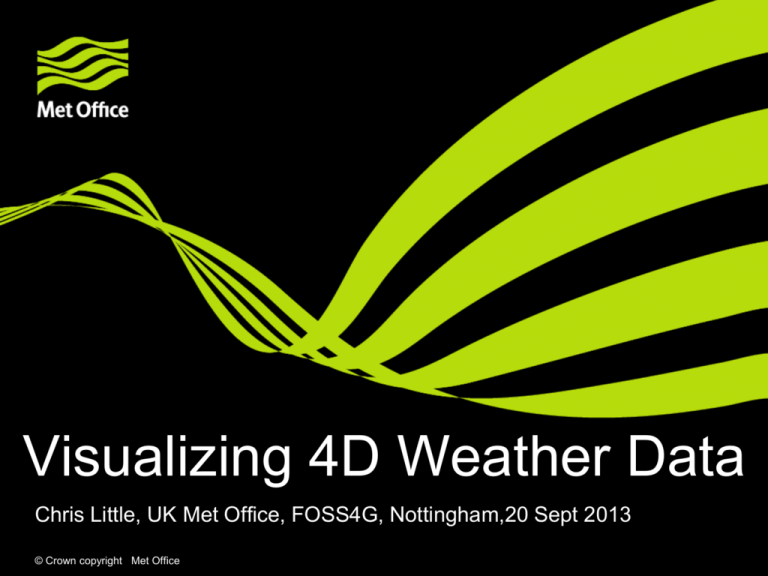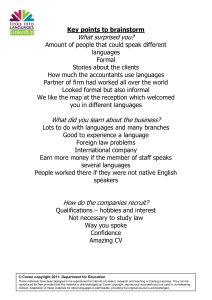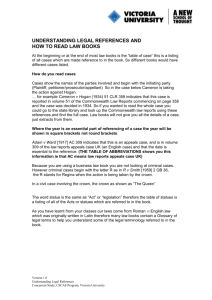Proposed_WCTS_SWG
advertisement

Visualizing 4D Weather Data Chris Little, UK Met Office, FOSS4G, Nottingham,20 Sept 2013 © Crown copyright Met Office Contents • Who, What, When, Why? • Meteorological Background • Current Forecasting Capability • How • Way Forward • Questions and answers © Crown copyright Met Office Who, What, When, Why? © Crown copyright Met Office Who? Chris Little, UK Met Office IT Fellow, Co-Chair OGC Met Ocean Domain WG chris.little@metoffice.gov.uk Christine Perey, Perey Research & Consulting Augmented Reality, Spime Wrangling cperey@perey.com Mike Reynolds, Augmented Technologies Ltd Founder & CEO, merging AR & geospatial AWILA: Augment What I Look At mike.reynolds@aug-tech.co.uk © Crown copyright Met Office Mont Blanc Geneva Thonon-les-Bains Lake Geneva What? Arriving in Montreux in 15 min camera, GPS, compass, accelerometer, micropho 3/14/2016 Now… can the invisible, such as forces of nature, be made more visible? 3/14/2016 From Maps & Wind Radar to Wind AR When? • 2012-10 Idea & quick plan in 30mins after long day at OGC TC Seoul • 2013-01 Proof of concept, canned demo Shown at OGC TC Redlands under NDA • 2013-02 Live Demo Mobile World Congress, Barcelona © Crown copyright Met Office Why? Current Users of AR • Well over 100M consumer-grade mobile devices are capable of supporting AR • Many mobile Web browsers have all necessary components for basic AR • Consumer applications continue to evolve • Many are “gimmicks” for product promotion • Industrial users are keen to begin using AR • Positive ROI has been demonstrated in many domains • Internal use cases permit use of controlled environments and well-defined devices Three challenging points From geospatial data to the service platform • Business data • Emergency data • Environmental data to service platform From service platform to end users • Professional and consumer • How do you do things locally (applies to this proximity)? • How do you serve this through a remote service provider • Real location versus Point of Interest POI Temporal adjustment of (geospatial) data • Time-indexed data to be viewed from/aa specific place, in real time • 4th dimension Existing practice Meteorology uses: • Point & Line data (BUFR) • Gridded data (GRIB) • In specialized standardized WMO formats to minimize bandwidth Augmented Reality uses: • Batch orientated • No levels or orography • No specific data formats • Streamed by location • Point/feature orientated • No time dimension other • Data is usually ‘all or nothing’ than ‘now’ fire-hose for large area of Earth • Interoperability just starting • 4D is natural • Interoperability for >100 years CONFIDENTIAL 3/14/2016 11 Meteorological Background © Crown copyright Met Office Wilhem Bjerknes Lewis Fry Richardson Jules Charney © Crown copyright Met Office Alan Turing John von Neumann CONFIDENTIAL 3/14/2016 14 Scales and Predictability Increasing scale Increasing lifetime Increasing predictability Model resolution Tornado 1km 10 minutes 30 minutes 200m Thunderstorm 10 km 1 hour 3 hours 2 km …but if we know what the planetary wave characteristics will be in 9 days, we can give an accurate probabilistic tornado forecast © Crown copyright Met Office Front 100 km 12 hours 36 hours 20 km Planetary Wave 10000 km 3 days 9 days 2000 km Influence of grid length on forecasts Forecast rainfall accumulations for 1200-1800UTC 16/8/2004 60km forecast from 00UTC 12km forecast from 00UTC © Crown copyright Met Office 5km radar actual 4km forecast from 00UTC 1km forecast from 00UTC Current Forecasting Capability © Crown copyright Met Office 3/14/2016 18 Current NWP Vertical resolution © Crown copyright Met Office NWP State of the Art 2013 15 Centres forecast Globally • 15-20Km resolution, 70-90 levels, 1-4 times/day • ~1MW electricity per supercomputer 70 Centres Regional/National/Local forecasts • <40 Centres have 1Km to 5Km resolution • 4-8 times/day 191 National Met Services: “authoritative voice” • Timeliness, expiry Ensembles: 12-24 simultaneous forecasts © Crown copyright Met Office How? © Crown copyright Met Office 3. Publication 4. Check availability 2. Transmission 1. Preparation 6. Response 5. Query Meteorological Services 3/14/2016 22 1. Data prepared internally (creation of forecast dataset) 2. Data transmitted to external facing server, chopped into tiles 3. Tiled data made 'visible' to client application's on-line content store 4. When client application queries on-line content store, it knows where and how to retrieve the wind dataset 5. Client queries tile-cache on Met Office data server for tiles covering the client's location 6. Necessary data is returned to the client app 7. Data processed on client application to 'AR friendly‘ 8. Wind AR information finally presented to user with options for navigating to more data via the UI © Crown copyright Met Office Proof of Concept details - 1 Amazon EC2 store (password protected) • • • • Agreement already in place Escalation Redundancy Authentication & Authorization Meteo data in WMO GRIB or NetCDF • 971 x 597 grid points • 4 / day ( fresh data every 6 hour) batch feeds • T-48 hours to T+36 hours in rolling buffer Convert to CSV grid in Lat/Long with IRIS & CartoPy AWILA converts CSV to Slippy Map tileset, Level 11 URL not Request/Response • 1 tile per level or time, 7.4MB • 1 tile for several parameters • 9 tiles around location © Crown copyright Met Office Wavefront OBJ model for the arrows Proof of Concept details - 2 AWILA: Augment What I Look At • Augmented Reality + Geospatial, written in Java • SQLServer for data Service Catalogue • Uses OGC Simple Features GeoAPI • Can change altitude of viewpoint • Can switch video on / off • Switch between real location and POI • Has time scroll • Ingest various data-streams (WFS, WMS, ESRI, pipe-work, weather data) • Can store data for canned replays along a route © Crown copyright Met Office Way Forward? © Crown copyright Met Office Future NWP 2015 • Global Models at 15 Km, 100 levels • National Models at 1 Km 2020 • Global models at 8 Km, ~150 levels • National models at 0.3 Km No global provider at <1 Km resolution, so interoperability essential © Crown copyright Met Office • UK Met Office wants to develop a system that is universal – Data from any source (including but not limited to UK) would work – As long as it is formatted in accordance with open data and our specifications – No interpolation – safety critical – Deterministic wind values unlikely ever to be finer than 100m and more frequent than 10 mins. • Benefits to using Amazon © Crown copyright Met Office Goal: Expand OGC Standards From Map Tiles to Data Tiles Web Map Services Web Coverage Services • Problem • Problem • Not sufficiently fast • Not sufficiently fast • Solution • Solution • Create Map Tiles • Create Data Tiles • Web Map Tile Service Ows-10?• Create Web Data Tile Service CONFIDENTIAL 3/14/2016 29 Immediate Experiments Easy • Windsocks not arrows • Multiple levels, vertical data set at specific place • Other providers • Standard WMO format before tiling • Flexible CartoPy, IRIS Slighter more work • Other parameters (how to visualise?) • Combine with orography • Combine with severe weather warning areas • Alternative to Amazon EC2 cloud © Crown copyright Met Office Way forward AWILA – More exposure of the AWILA browser – Increase usefulness, visibility PEREY – To make the invisible visible – To make AR useful – Explore 3D AR Meteorology – OGC standard for data tiling – OGC 4D and time mainstream – Common interface for real time & archived data Questions & answers © Crown copyright Met Office Questions & Answers © Crown copyright Met Office CONFIDENTIAL 3/14/2016 34 Meteorological Satellites CONFIDENTIAL 3/14/2016 35 Choose Data Sets CONFIDENTIAL 3/14/2016 36 Initial Requirements Technical Requirements • Make 3D objects interact with things that don’t move • Data presentation in vertical plane • Temporal plane (time varying) • Real time • Play back (time series) Business Requirements • Location and data accuracy • Location and data precision • One data set, many services • One device, many data sets • Any network, any device and all data sets Relevant OGC Standards Established • CityGML Emerging • GeoSMS • WMS • Indoor GML • Web Map Tiling Service • ARML 2.0 • SLD/SE • Sensor Web for IoT • WFS/T • WCS • Open LS • GeoPackage • Sites for Mobile Other Standards W3C • Many relevant standards Khronos Group • WebGL • OpenGL ES United Nations ITU/ISO/WMO • H.264 • TC-211 • Meteorological: GRIB, BUFR,… • OpenSL • COLLADA • StreamInput • MPEG ARAF OASIS • MPEG-V • Common Alerting Protocol (CAP) Potential Impacts of the Work • Increase real time access to geospatial data • Increase temporal element in geospatial • Increase use of 3D • Greater cooperation with other SDOs • Relevance of OGC standards • Professional • Government • Consumer are all Lat Long Managed services require the policies are observed • Data on device will erase itself after time interval • Authentication and safe guards • Must be a real time service • Classic example is Meteoalarm • Weather alarms for Europe • Green / Yellow / Red • White (outdated information) • Gray (where there is no information) 3D data void? • Need something similar safeguard in the service in the roadmap for commercial/managed service © Crown copyright Met Office © Crown copyright Met Office





